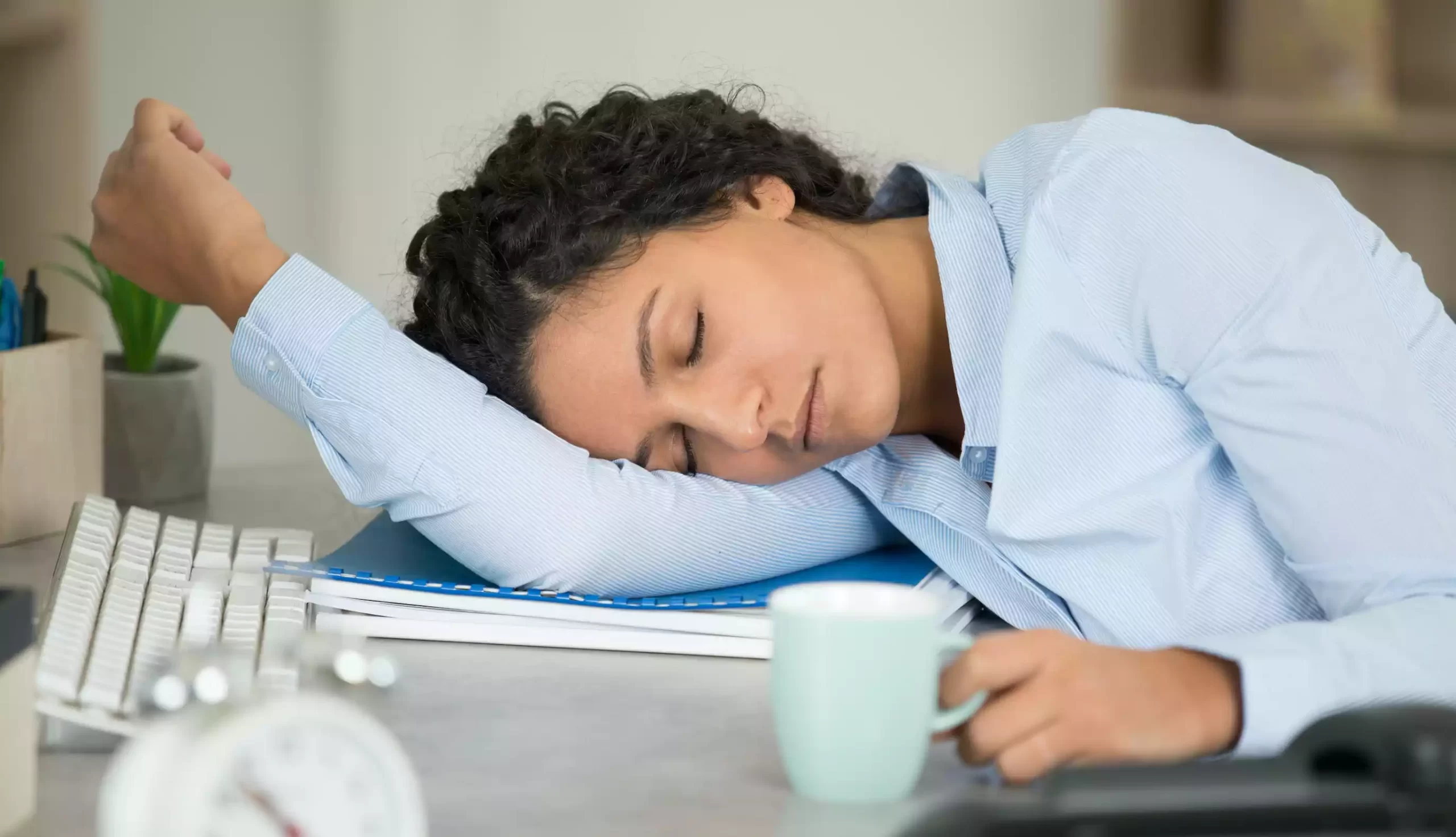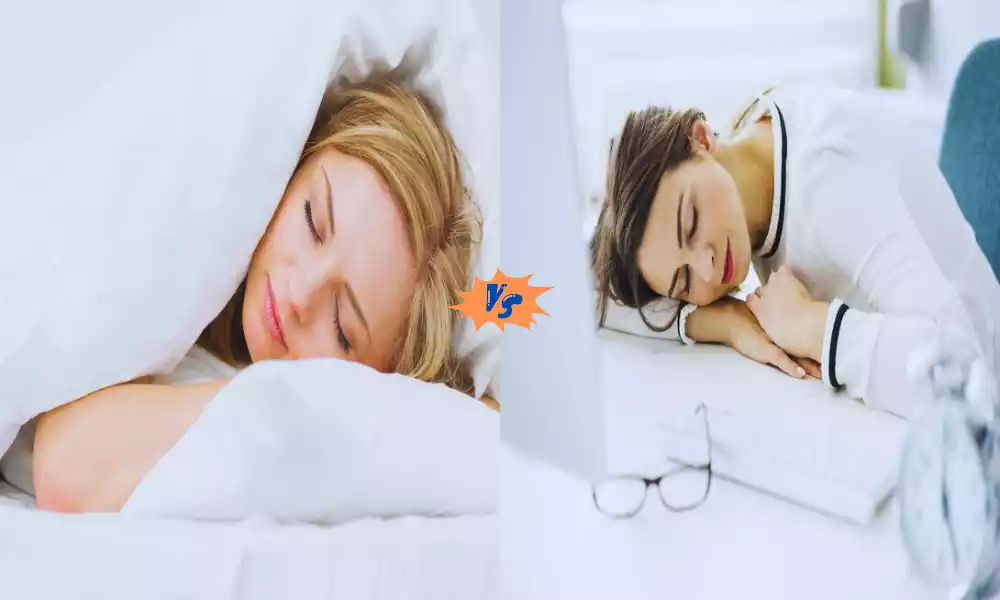Idiopathic Hypersomnia and Narcolepsy are both sleep disorders that disrupt normal sleep patterns. Idiopathic hypersomnia is characterized by excessive daytime sleepiness without sudden “sleep attacks” seen in narcolepsy. Narcolepsy involves sudden, uncontrollable episodes of sleep during the day and can also lead to muscle weakness triggered by emotions. These conditions can significantly impact daily life and require proper diagnosis and management.
What is Idiopathic Hypersomnia?

Idiopathic Hypersomnia is a rare and chronic sleep disorder characterized by excessive daytime sleepiness (EDS) and an overwhelming urge to sleep during the day, even after a full night’s sleep. Unlike narcolepsy, which is another sleep disorder with similar symptoms, idiopathic hypersomnia does not involve cataplexy (sudden loss of muscle tone), sleep paralysis, or hallucinations.
The term “idiopathic” means that the cause of hypersomnia is unknown, and it is considered a diagnosis of exclusion, meaning other potential causes of excessive daytime sleepiness must be ruled out before a diagnosis of idiopathic hypersomnia is made.
Individuals with this disorder often find it challenging to stay awake and alert during normal daytime activities, and they may experience significant disruptions in their daily lives as a result. Treatment for idiopathic hypersomnia typically involves managing symptoms with medications and lifestyle adjustments.
Causes of Idiopathic Hypersomnia
The exact cause of Idiopathic Hypersomnia (IH) remains unknown, which is why it is referred to as “idiopathic,” meaning that the cause cannot be identified. Researchers have proposed several potential factors that may contribute to or be associated with IH, though none have been definitively proven as the sole cause.
Some of these factors and hypotheses include:
- Genetics: There may be a genetic predisposition to idiopathic hypersomnia, as it can sometimes run in families.
- Brain Chemistry: Disruptions in neurotransmitters or other brain chemicals involved in wakefulness and sleep regulation may play a role.
- Hypothalamic Dysfunction: Some research suggests that issues within the hypothalamus, a region of the brain that regulates sleep and wakefulness, could be involved.
- Immune System Abnormalities: Like in some other sleep disorders, there might be an autoimmune component in idiopathic hypersomnia, where the immune system mistakenly attacks certain brain cells or receptors involved in wakefulness.
- Brain Structural Abnormalities: Structural abnormalities in the brain, although not always present, have been reported in some individuals with IH.
- Infections or Illness: In rare cases, a viral infection or other illness may trigger the onset of idiopathic hypersomnia.
- Environmental Factors: Some environmental factors, such as exposure to toxins or head injuries, have been considered as potential triggers, although this is less common.
Research is needed to understand the precise causes of idiopathic hypersomnia fully. Diagnosis is typically made through a process of exclusion, ruling out other potential causes of excessive daytime sleepiness. Treatment focuses on managing the symptoms and improving an individual’s quality of life, often with the use of medications and lifestyle adjustments.
Symptoms of Idiopathic Hypersomnia
Idiopathic Hypersomnia (IH) is characterized by a range of symptoms related to excessive daytime sleepiness and disrupted sleep patterns. The primary symptoms of IH include:
- Excessive Daytime Sleepiness (EDS): Individuals with IH experience an overwhelming and persistent need to sleep during the day, often leading to uncontrollable daytime sleep episodes. This excessive sleepiness can interfere with daily activities and responsibilities.
- Prolonged Daytime Sleep: Unlike a typical nap, individuals with IH may experience episodes of prolonged and non-refreshing daytime sleep, often lasting for several hours at a time.
- Difficulty Waking Up: People with IH often find it exceptionally difficult to wake up in the morning, even after a full night’s sleep. This difficulty in waking up, known as sleep inertia, can result in grogginess and confusion upon awakening.
- Sleep Inertia: Sleep inertia refers to the feeling of extreme grogginess and disorientation experienced upon awakening. Individuals with IH may struggle to become fully alert upon waking, which can affect their morning routine.
- Long Sleep Duration: Despite their excessive daytime sleepiness, individuals with IH may sleep for an extended duration during the nighttime, often more than the average recommended amount of sleep.
Individuals may experience symptoms with different degrees of severity. IH is typically diagnosed through the exclusion of other potential causes of excessive sleepiness, making it a diagnosis of exclusion. Treatment options for IH primarily focus on managing symptoms, often with the use of stimulant medications and lifestyle adjustments to improve wakefulness and daily functioning.
What is Narcolepsy?

Narcolepsy is a neurological sleep disorder characterized by excessive daytime sleepiness, sudden and uncontrollable episodes of falling asleep during activities, and distinct symptoms such as cataplexy (sudden muscle weakness or paralysis), sleep paralysis, and vivid hallucinations when falling asleep or waking up.
This condition disrupts normal sleep patterns, making it challenging for individuals to stay awake and alert during the day and leading to frequent disruptions in daily life. While the exact cause of narcolepsy is not fully understood, it is believed to involve genetic and autoimmune factors. Treatment typically involves managing symptoms through medication and lifestyle adjustments.
Causes of Narcolepsy
Narcolepsy is a complex neurological disorder, and its exact cause is not fully understood. Research suggests that narcolepsy is primarily associated with genetic, autoimmune, and environmental factors.
Here are some of the leading factors believed to contribute to narcolepsy:
- Genetics: There is a strong genetic component to narcolepsy. Anyone who comes from a family where the disease exists has an increased risk of contracting it themselves. Specific genes, such as HLA-DQB1*06:02, have been associated with an increased susceptibility to narcolepsy.
- Autoimmune Response: One of the prevailing theories is that narcolepsy is triggered by an autoimmune response. It is believed that the immune system mistakenly attacks and destroys certain brain cells or receptors involved in regulating wakefulness and sleep. This autoimmune response is thought to lead to a deficiency in the neurotransmitter hypocretin (also called orexin), which plays a crucial role in sleep-wake regulation.
- Infections: In some cases, infections, particularly streptococcal infections, have been associated with the onset of narcolepsy. It is thought that the immune response triggered by these infections may contribute to the autoimmune process that damages hypocretin-producing cells.
- Brain Abnormalities: Structural abnormalities or lesions in the hypothalamus, which is the region of the brain responsible for regulating sleep and wakefulness, have been observed in some individuals with narcolepsy. These abnormalities may disrupt the normal functioning of sleep-wake control centers.
- Environmental Factors: Certain environmental factors, such as head injuries, hormonal changes, and stress, may potentially contribute to the development of narcolepsy in susceptible individuals. These factors are thought to play a lesser role compared to genetic and autoimmune factors.
While these factors are associated with narcolepsy, the condition can still occur without a clear trigger or family history. Narcolepsy is typically diagnosed through clinical evaluation and specialized sleep studies. Treatment primarily focuses on managing symptoms, and medications like stimulants and antidepressants are often prescribed to help individuals with narcolepsy improve wakefulness and manage other symptoms like cataplexy and sleep paralysis.
Symptoms of Narcolepsy
Narcolepsy is a neurological sleep disorder characterized by a range of symptoms related to disrupted sleep patterns and excessive daytime sleepiness (EDS). The primary symptoms of narcolepsy include:
- Excessive Daytime Sleepiness (EDS): Individuals with narcolepsy experience overwhelming and persistent daytime sleepiness, often leading to sudden and uncontrollable episodes of falling asleep during activities such as work, school, or social interactions.
- Cataplexy: Cataplexy is a distinctive symptom of narcolepsy, characterized by sudden and temporary muscle weakness or paralysis, typically triggered by strong emotions, particularly laughter, surprise, or anger. It can range from mild muscle weakness, such as drooping facial muscles, to a complete loss of muscle control.
- Sleep Paralysis: Narcoleptic individuals may experience sleep paralysis, a temporary inability to move or speak while falling asleep or waking up. Sleep paralysis can be accompanied by vivid and often frightening hallucinations.
- Hypnagogic and Hypnopompic Hallucinations: These are vivid dream-like experiences or hallucinations that occur when falling asleep (hypnagogic) or waking up (hypnopompic). These hallucinations can be visually, auditorily, or tactilely vivid and are often disorienting.
- Fragmented Nighttime Sleep: People with narcolepsy may have disrupted nighttime sleep patterns, including frequent awakenings and vivid dreams, which contribute to the excessive daytime sleepiness.
The severity and combination of these symptoms can vary among individuals with narcolepsy. Some may experience all of these symptoms, while others may have only a subset. Narcolepsy can significantly impact a person’s daily life, including their ability to work, drive, and engage in social activities. Diagnosis is typically made through clinical evaluation and specialized sleep studies, such as polysomnography and the Multiple Sleep Latency Test (MSLT). Treatment focuses on managing symptoms and may include medications to improve wakefulness and address cataplexy, sleep paralysis, and hallucinations.
Comparison Table of Idiopathic Hypersomnia and Narcolepsy
Here’s a comparison table summarizing the key differences between Idiopathic Hypersomnia and Narcolepsy:
| Characteristic | Idiopathic Hypersomnia | Narcolepsy |
|---|---|---|
| Definition | Chronic sleep disorder characterized by excessive daytime sleepiness, without cataplexy, sleep paralysis, or hallucinations. | Chronic sleep disorder characterized by excessive daytime sleepiness, often with cataplexy, sleep paralysis, and hallucinations. |
| Cataplexy | Absent | Present in most cases |
| Sleep Paralysis | Less common | Common |
| Hypnagogic/Hypnopompic Hallucinations | Less common | Common |
| Sleep Latency on MSLT | Longer sleep latency | Shortened sleep latency |
| Sleep Inertia | Common | Less common |
| Causes | Unknown (idiopathic) | Genetic and autoimmune factors, possibly triggered by infections. |
| Genetic Predisposition | Possible genetic predisposition | Strong genetic component (HLA-DQB1*06:02) |
| Diagnosis | Diagnosis of exclusion, ruling out other potential causes of excessive sleepiness. Multiple Sleep Latency Test (MSLT) may also be administered. | Clinical evaluation, polysomnography (PSG), and MSLT for confirmation. |
| Treatment | Symptomatic relief with stimulants (e.g., modafinil), lifestyle adjustments, and psychological support. | Medications for symptom management (e.g., stimulants, sodium oxybate), lifestyle adjustments, and supportive therapies. |
| Overall Prevalence | Rare | Less common than idiopathic hypersomnia, but still relatively rare. |
| Impact on Daily Life | Significant daytime impairment but less dramatic than narcolepsy. | Profound daytime impairment, often more severe due to cataplexy and other symptoms. |
Individual experiences with these disorders can vary, and diagnosis and treatment should always be guided by a healthcare professional specializing in sleep medicine.
How to diagnosis of Idiopathic Hypersomnia and Narcolepsy
The diagnosis of Idiopathic Hypersomnia and Narcolepsy involves a combination of clinical evaluation, sleep studies, and specialized testing conducted by a healthcare professional, typically a sleep specialist.
Here’s an overview of the diagnostic process for each of these sleep disorders:
Diagnosis of Idiopathic Hypersomnia:
- Clinical Evaluation: The process usually begins with a comprehensive medical history and physical examination. The healthcare provider will ask about your sleep patterns, daytime sleepiness, and other symptoms.
- Exclusion of Other Disorders: Idiopathic Hypersomnia is a diagnosis of exclusion, meaning other potential causes of excessive daytime sleepiness must be ruled out. This may involve testing for conditions such as sleep apnea, narcolepsy, restless legs syndrome, and other medical and psychiatric disorders that can mimic hypersomnia.
- Multiple Sleep Latency Test (MSLT): The MSLT is a key diagnostic tool for distinguishing Idiopathic Hypersomnia from other sleep disorders. During this test, you’ll be asked to take multiple short naps in a quiet, dark room over the course of a day. If you have Idiopathic Hypersomnia, you’ll tend to fall asleep quickly and enter rapid eye movement (REM) sleep during these naps.
- Polysomnography (PSG): In some cases, a polysomnogram may be performed to rule out other sleep disorders and monitor nighttime sleep patterns. PSG is not specific to Idiopathic Hypersomnia and is often used more to exclude other conditions.
Diagnosis of Narcolepsy:
- Clinical Evaluation: As with Idiopathic Hypersomnia, the diagnostic process for narcolepsy begins with a thorough medical history and physical examination. The healthcare provider will inquire about your sleep patterns, episodes of sudden muscle weakness (cataplexy), sleep paralysis, and vivid dream-like experiences.
- Polysomnography (PSG): An overnight polysomnogram may be conducted to rule out other sleep disorders, such as sleep apnea. PSG monitors various physiological parameters during sleep, including brain activity, eye movements, heart rate, and muscle activity.
- Multiple Sleep Latency Test (MSLT): The MSLT is a critical diagnostic tool for narcolepsy. After an overnight PSG, you will take a series of short daytime naps in a controlled environment. Individuals with narcolepsy typically fall asleep quickly during these naps and enter REM sleep sooner than normal.
- Hypocretin/Orexin Levels: In some cases, cerebrospinal fluid (CSF) may be analyzed to measure levels of hypocretin/orexin, a neurotransmitter associated with narcolepsy. Low levels of hypocretin/orexin are indicative of narcolepsy type 1 (with cataplexy).
- Genetic Testing: Genetic testing may be performed to identify specific genetic markers associated with narcolepsy, particularly HLA-DQB1*06:02.
It’s important to consult a healthcare professional, preferably a sleep specialist, if you suspect you have either Idiopathic Hypersomnia or Narcolepsy. These specialists have the expertise to conduct the necessary evaluations and tests to provide an accurate diagnosis and recommend appropriate treatment options. Early diagnosis and management can significantly improve the quality of life for individuals with these sleep disorders.
Treatment for Idiopathic Hypersomnia and Narcolepsy
Treatment for Idiopathic Hypersomnia and Narcolepsy typically focuses on managing symptoms and improving wakefulness and daytime functioning. It’s important to note that these treatments may not provide a cure but can help individuals better manage their conditions. Treatment plans are often personalized based on the severity of symptoms and individual needs.
Here are the common treatment approaches for Idiopathic Hypersomnia and Narcolepsy:
Treatment for Idiopathic Hypersomnia:
- Stimulant Medications: Stimulants such as modafinil and armodafinil are commonly prescribed to help improve wakefulness and reduce excessive daytime sleepiness. These medications are considered the first-line treatment for Idiopathic Hypersomnia.
- Lifestyle Adjustments: Lifestyle modifications can help manage symptoms. These may include maintaining a regular sleep schedule, avoiding alcohol and caffeine close to bedtime, and incorporating short naps strategically to combat sleepiness.
- Cognitive-Behavioral Therapy (CBT): CBT techniques, such as sleep hygiene and sleep education, can be beneficial in managing sleep patterns and improving daytime functioning.
- Psychological Support: Dealing with the chronic nature of Idiopathic Hypersomnia can be emotionally challenging. Psychological counseling or support groups can help individuals cope with the impact on their daily lives.
- Experimental Therapies: In some cases, individuals with Idiopathic Hypersomnia may be offered experimental treatments or participate in research studies to explore new therapeutic options. These therapies should be considered carefully with the guidance of a healthcare provider.
Treatment for Narcolepsy:
- Stimulant Medications: Stimulants like modafinil, armodafinil, and methylphenidate are often prescribed to manage excessive daytime sleepiness in individuals with narcolepsy. These medications can help improve wakefulness and alertness.
- Sodium Oxybate (Xyrem): This medication is considered the standard treatment for cataplexy and excessive daytime sleepiness in narcolepsy. It is taken at bedtime and can help consolidate nighttime sleep and reduce cataplexy episodes.
- Antidepressant Medications: Tricyclic antidepressants or selective serotonin reuptake inhibitors (SSRIs) may be prescribed to manage cataplexy and other symptoms associated with narcolepsy.
- Lifestyle Adjustments: People with narcolepsy can benefit from maintaining a consistent sleep schedule, avoiding alcohol and caffeine close to bedtime, and practicing good sleep hygiene.
- Scheduled Naps: Planned short naps during the day can help manage sleepiness and improve alertness. These naps should be strategically timed to prevent excessive daytime sleepiness.
- Supportive Therapies: Supportive therapies, such as counseling or support groups, can help individuals cope with the emotional and social challenges of living with narcolepsy.
- Hypocretin Replacement Therapy (Experimental): In some cases, experimental therapies aimed at replacing or increasing hypocretin levels may be explored. These treatments are still in the research phase and not widely available.
The choice of treatment depends on the specific symptoms and needs of the individual, and it should be determined in consultation with a healthcare provider, preferably a sleep specialist. The goal of treatment is to improve overall quality of life by managing symptoms and allowing individuals to engage in daily activities more effectively.
Final Thoughts
Idiopathic Hypersomnia and Narcolepsy are two distinct but related sleep disorders that both involve excessive daytime sleepiness. Idiopathic Hypersomnia is characterized by profound daytime sleepiness without cataplexy or other specific features, and its cause remains unknown. In contrast, Narcolepsy is marked by excessive daytime sleepiness often accompanied by cataplexy, sleep paralysis, and vivid hallucinations.
While the precise causes of both disorders are not fully understood, they have different diagnostic criteria and treatment approaches. Accurate diagnosis and individualized treatment plans, including medication and lifestyle adjustments, are essential in managing the symptoms and improving the quality of life for those affected by these sleep disorders.



